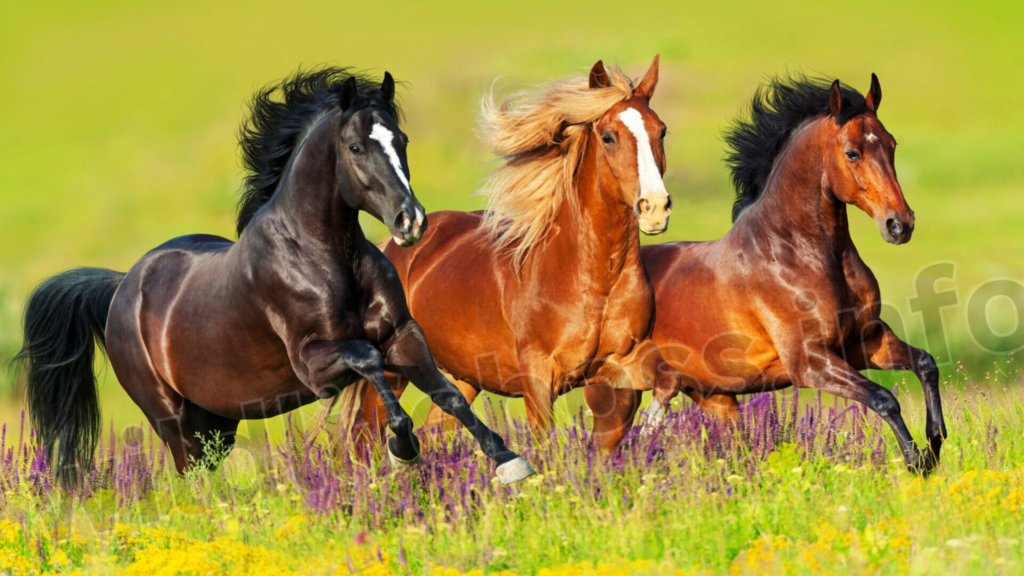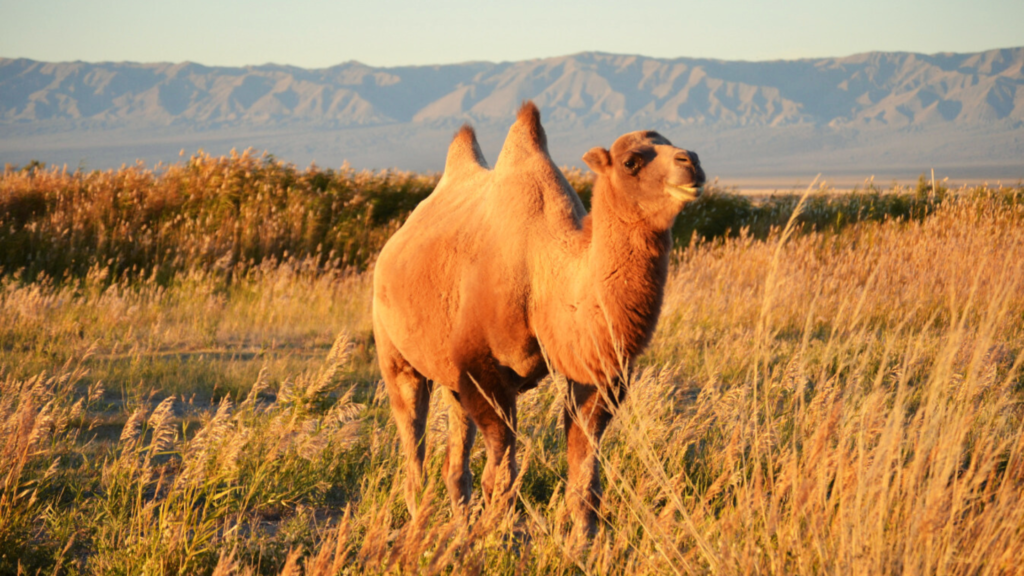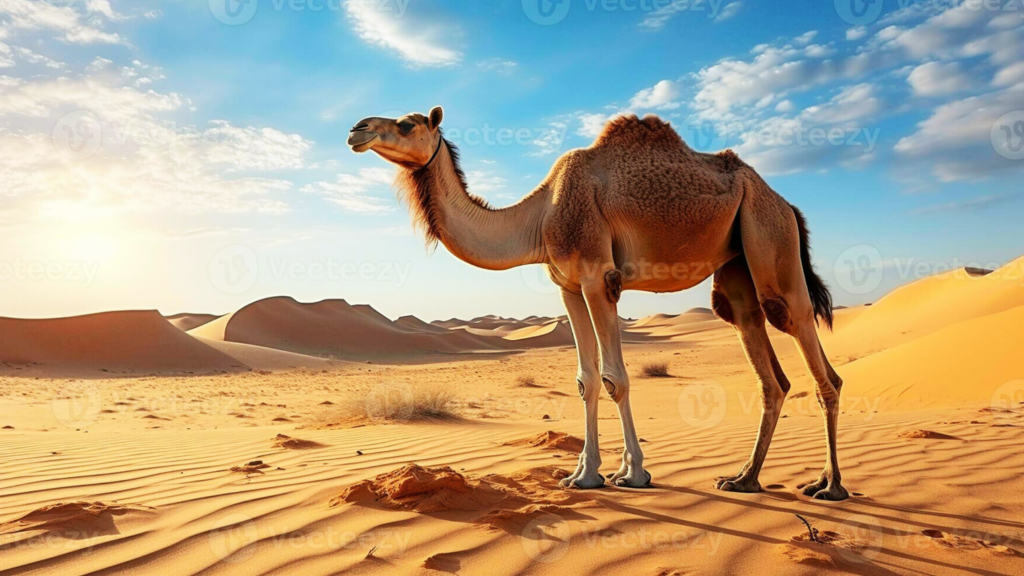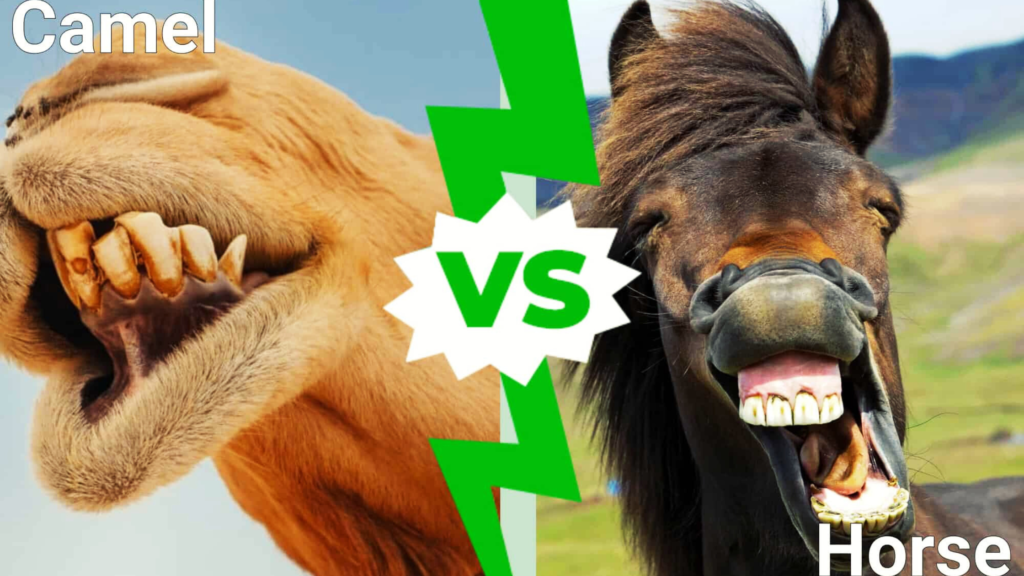Camel vs horse are two examples of domesticated, practical animals. However, there are still wild populations in many regions of the world.
Because of their strength, camels are able to carry bigger weights than horses. Additionally, they are more resilient, living on little water and walking for days on end in the scorching sun. Horses may bite harder and move more quickly than camels. Both are believed to have above-average intelligence, even though camels are smarter than other animals.
A brief summary of the differences between camel vs horse is provided in the table below:
| Characteristics | Camels | Horses |
|---|---|---|
| Classification (family) | Camelidae | Equidae |
| Appearance | Large bodies with one or two humps, depending on the species, and a long, curving neck. It ranges in color from deep gray to caramel. Pad-shaped feet designed for sand travel. | They have long, thick necks, extended heads, and muscular, slender bodies. Manes run the length of the neck’s dorsal side. Colors range from black to white. Horses with single-hoof feet can accelerate and withstand stress. |
| Size | 7.2 to 11.5 feet long | 7.2 to 9.1 feet long |
| Weight | 660 to 1,500 pounds | 500 to 2,200 pounds |
| Speed | 20 – 25 mph | 40 -55 mph |
| Endurance (time without water) | 7 months | 48 to 72 hours |
| Carrying capacity | 375 -600 pounds | 100 – 440 pounds |
| Bite force | 398 PSI | 500 PSI |
| Diet | Herbivore | Herbivore |
| Behavior | Social | Social |
| Reproduction | Polygamous; 2-year breeding interval | Polygamous; breeding once a year |
| Lifespan (in the wild) | 40 years | 36 years |
| Geographic range | Africa, Asia, Middle East | Worldwide |
The information in the before table pertains to camel vs horse in general. Specifics and factors can differ between subspecies. Research papers, journals, studies, and other official sources were the sources of all the data.
sea also: 10 Different Animals Like Cows (With Photos)
Camel Vs Horse: 13 Key Differences
1. Classification

Although they are both herbivores, horses and camels are members of separate families.
Camels are members of the Camelidae family, which also includes llamas, guanacos, and alpacas. Together with zebras and asses, horses are members of the Equidae family.
While camels belong to the even-toed ungulate genus Artiodactyla, horses are in the same order as rhinoceroses and tapirs.
2. Appearance
Despite being huge ungulates, horses and camels have incredibly different appearances.
Horses’ bodies and legs are muscular and long. Also they possess muscular and long necks, manes are of different lengths according the breed. From white to black, and all colors in between roan and pinto horses in a variety of colors, coats are lustrous and sleek.
Camels’ bodies are stockier and feature one or two humps, but they too have long, powerful legs. They have long, curving necks and faces and mouths similar to llamas.
In contrast to horses, camels have coarser, thicker coats that range in hue from a darker shade of brown to a yellowish-brown.
3. Size
Camel vs horse reach comparable heights, although camels are typically a little bigger.
In specifics, camels can reach lengths of 7.2 to 11.5 feet. Although the greatest horses rarely grow to be more than 9.1 feet long, the majority of adult horses are likewise at least 7.2 feet long.
Horses reach a shoulder height of roughly 5.75 feet, while most camels reach a hump height of over 7 feet.
4. Weight

Horses are typically heavier than camels, despite their smaller stature. Horse weight can range from 2,200 pounds to more, depending on the breed.
The heaviest camels weigh barely more than 1,500 pounds, making them far lighter than other animals.
Horses’ heavier weight is typically explained by their intended purpose.
These days, wild horses are quite uncommon; domesticated horses are raised for racing or for practical needs, both of which call for powerful muscles. They weigh more as a result.
5. Speed
Horses are frequently connected with speed and competition. It is common to imagine camels as docile yet resilient creatures that can traverse deserts for days at a time; nonetheless, they are not supposed to be swift.
With top speeds of 55 miles per hour, horses are actually roughly twice as quick as camels.
Although they can gallop up to 25 miles per hour, camels typically move much more slowly.
6. Endurance (Time Without Water)
Although camels are not as fast as horses, they are far more resilient; they can go up to 15 days without drinking any water at all and survive for up to seven months on very little water.
They can continue to travel through the desert while carrying loads throughout this period.
Horses, on the other hand, can only go 72 hours without water. But within 24 to 48 hours, most horses will no longer perform as well.
Camels’ humps are what give them their exceptional endurance. These protuberances don’t really hold water; camels may convert the fatty tissue that makes up their humps into water and food at times when resources are limited.
The camels’ humps get smaller and more pliable as they eat these deposits. As soon as the animal has access to resources, they return to their initial size and shape.
7. Carrying Capacity

One of the many things camels can do is endure for extended periods of time without water. More weight may be carried by them than by horses.
Camels can typically carry 375–600 pounds, or roughly 40% of their overall weight, on their backs. Even so, some of the strongest people are capable of carrying up to 900 pounds.
It is established that horses can bear about 20 percent of their weight or between 100 – 440 pounds.
If a horse is able to transport loads of up to 35% of its own body weight then camels can transport loads much heavier than even horses.
8. Bite Force
Horses bite stronger than camels, despite the latter’s physical strength. Nonetheless, the jaws of both mammals are powerful enough to cause severe harm.
Research indicates that camels can bite with a force of 28 kg/cm2, or 398 PSI. The force is strong enough to rip bones from flesh.
Horses, for instance, possess far more robust jaw muscles, and can chomp with 500 PSI. They also have the capabilities of breaking bones from the mouth and tearing flesh from the bones.
9. Diet
Camel vs horse are good animals as they are vegetarians, although, depending on their countries they are located in, they have different fodder.
As grazers, horses consume a lot of grasses and cloves. Horses in the wild also consume leaves, fruits, tree buds, and occasionally even bark.
Particularly during the colder months, domestic horses typically consume large amounts of hay and grain.
Camels live in harsher temperatures, yet they are grazers as well. As a result, they frequently exploit whatever plant is accessible.
Domesticated camels consume more hay and grains, much like horses do.
10. Behavior

Like horses, camels are gregarious mammals that usually reside in herds.
Herds of wild or feral horses usually comprise of one to four stallions and up to eleven mares with their young, and they have a distinct social hierarchy.
There is an alpha male in every herd who rules over the others. All stallions control the females, whereas breeding females control the young and non-reproductive females.
Camels typically have a family-based social structure, but they can live in groups of up to 20 people. One male, multiple females, subadults, and young make up a herd, or caravan.
Although both species are migratory, wild horses are usually crepuscular, while camels are diurnal.
11. Reproduction
Camel vs horse have somewhat different reproductive processes, while having comparable social structures.
Although male camels usually keep the females in their herd from mating with other males, both species are polygamous.
In general, female camels breed once every two years and attain sexual maturity around the age of three.Horse females typically reproduce once a year and attain sexual maturity between the ages of one and four.
12. Lifespan
Although camels live a little longer than horses, their life expectancies are comparable.
For example camels it has a life expectancy of 40 years in the wilds. The life expectancy of a wild horse is 36 year on average.
For animals kept in captivity, however, the situation is reversed; horses can live up to 61 years, while camels only live around 50.
13. Geographic Range
The finding also showed that the geographical range of camel vs horse differ; camels are distributed in a more limited area as compared to horses.
However, wild horse population is extremely rare across the world but can be seen in all the continents excluding the Antarctica.
Camels are found only in Africa, Asia, and the Middle East.
Which One Is Smarter?
There is also no doubt that the owners of horses and the horses themselves are good neighbours. But do they really know more than these camels?
A study suggests that encephalization quotient (EQ) of Bactrian and dromedary camels is 1.3. The EQ of horses is 0.78.
Scientists use a table known as the encephalization quotient to compare the intelligence of one species to that of another. This study proves that those who believe in camel superiority over horses are right in arguing about that.

